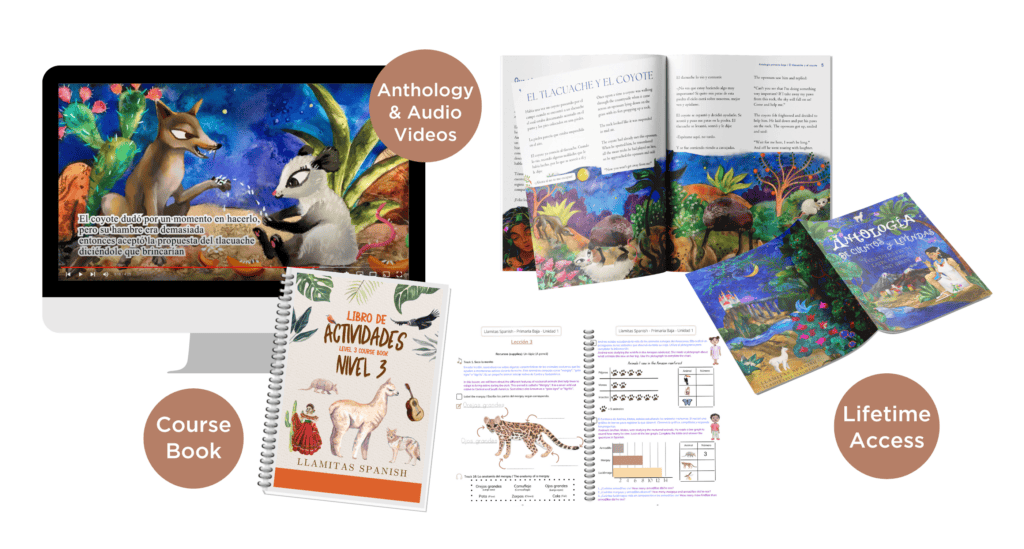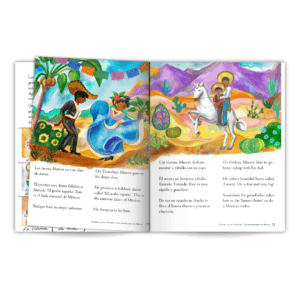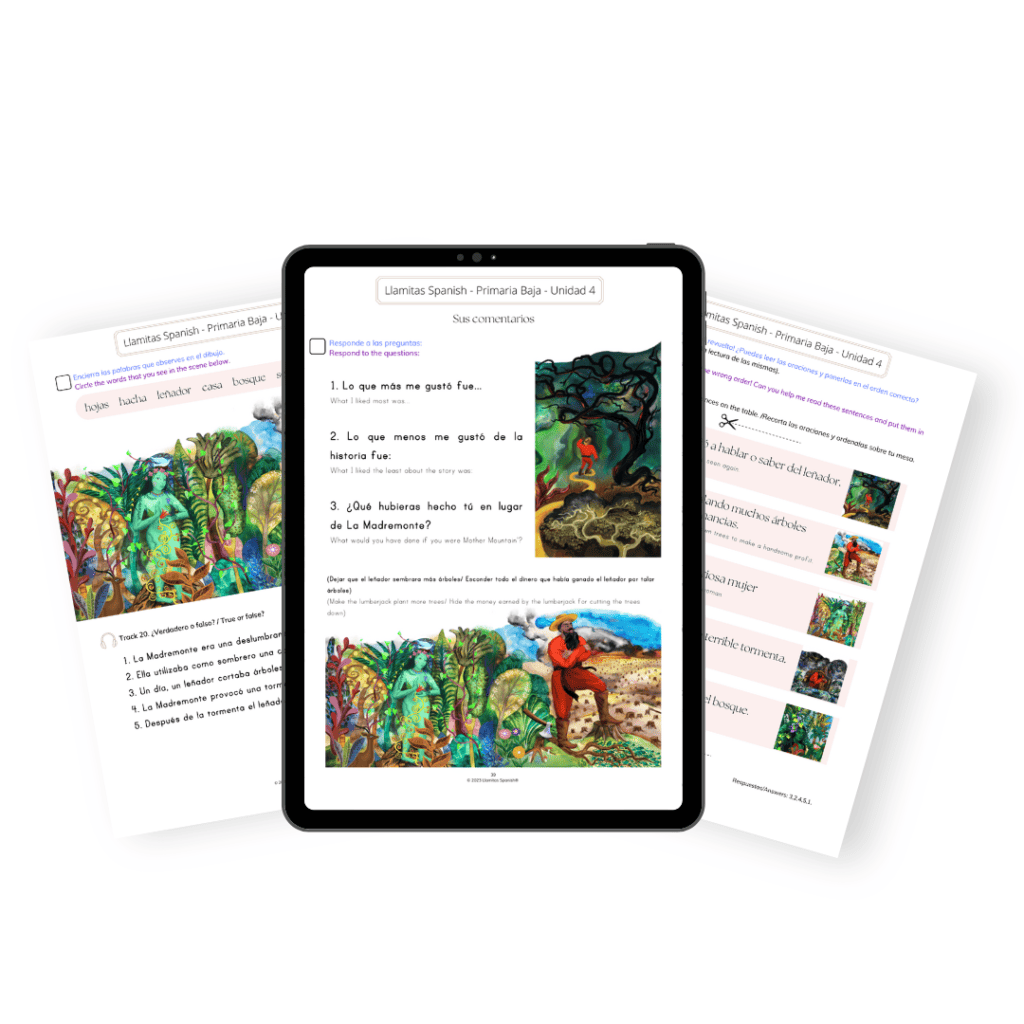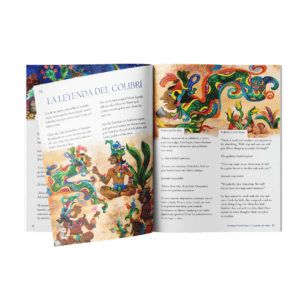In this post: Learn how to use elementary Spanish stories from our Curriculum to support your child’s literacy.

Stories are a powerful tool.
Recently, I attended a baby shower where guests were asked to bring one of their favorite children’s books along to share. Each of us had strong memories and emotions tied to books from our childhood, and many of the parents also brought books that they had fond memories of reading with their children, too.
It was amazing to see the lasting impact that simple picture books could have throughout our lives and the way that they can bring people together.
Knowing the importance of reading for literacy, my family has always incorporated reading together into our bedtime routine. It’s such a simple way to bond with your child and support their development without much effort at all.
In this way, we can also support our children’s biliteracy through stories. Reading a good story together naturally engages your child and opens their mind to more effective language learning in a way that most textbooks can’t.
Raising biliterate children goes hand in hand with raising bilingual children. Literacy is a core part of their education in those elementary years. At Llamitas Spanish®, we believe it’s important to choose authentic and deeply rooted stories that promote biliteracy and cultural appreciation.

Find out how to use the power of storytelling to teach your child Spanish at home and support their biliteracy!
Table of Contents
The Power of Storytelling for Learning Spanish
Storytelling is a powerful tool for learning Spanish, or any subject for that matter. To illustrate, maybe you can dig deep into your memories of back when you were in school.
Picture it: It’s a beautiful, sunny afternoon, and your teacher is giving a lecture on the periodic table or the quadratic formula. Before you know it, your eyelids begin to grow heavy, and you sink further into that hard, plastic seat, your head drooping closer toward your desk. (Okay, I wasn’t exactly a math and science person.)
So, maybe you didn’t commit the entire periodic table to your long-term memory. But, if you go even further back, you can almost certainly remember the famous story about Benjamin Franklin’s kite experiment, where he discovered that lightning was electricity. Why is that?
Aside from the obviously more complex subject matter, it’s because we are drawn to stories. It’s a part of our human nature. Stories not only have the power to paint a vivid picture in our mind, but they also help us feel connected to others and the world around us.
How can Stories Support Biliteracy?
So, what does all of this have to do with learning Spanish? When we teach language through stories, we can create more meaningful, lasting connections in the brain for more effective learning.
Here are just a few reasons you should be reading Spanish stories with your child to support their biliteracy:
- It allows them to work on specific language skills (reading, listening, speaking, comprehension, etc.) in context.
- Stories are engaging and fun—they keep our interest.
- Narratives mirror how our brains work and how we learn new information.
- Stories are “sticky.” They stay with us because they are meaningful, engaging our senses, our hearts, and our minds.

Learning Spanish in Context
Over the past few decades, there has been a lot of research on the connection between storytelling and language learning. Again and again, studies have found storytelling to be extremely effective in language learning, often even more so than traditional teaching methods (Lucarevschi 2018).
One of the most obvious reasons is that stories are an easy and practical way to apply and practice language skills, like reading and listening. When your child is learning Spanish, for example, being able to apply the vocabulary and grammar they’ve learned in the context of a story will make it much more meaningful than simply memorizing lists and charts.
For children especially, illustrations, repetition, and expressive body language will aid in their comprehension, while also creating a fun and engaging experience (Lucarevschi 2018).
The Staying Power of Stories
As you can imagine, when your child is interested and engaged with what they’re learning, they’re much more likely to retain it. In fact, one study found that students performed significantly better on assessments when content was presented in a narrative format—with an engaging story—versus a more traditional, non-narrative approach (Arya & Maul 2012).
If you put yourself in the students’ seat, it’s easy to see why a story format would keep their interest more than drilling facts from a textbook. We are naturally drawn to stories and are constantly creating narratives throughout our day, whether we realize it or not.
This is a huge part of why telling stories can be so effective for learning: “Storytelling works because it parallels the ways in which we receive, analyze, organize, and archive any information that comes into our brains. Facts enter as data points; stories connect the dots” (Boris & Peterson 2018).
In other words, stories help us to make sense of all of the information we are taking in. Reading Spanish stories can help your child to apply all of the vocabulary and grammar they’ve been studying and apply it in a meaningful way.
This effectively rewires the brain, allowing new information to “stick” and helping us to recall it later. “Through new and updated stories, we absorb incoming facts, make connections, and interpret meaning. And changes to neural pathways actually happen” (Boris & Peterson 2018).
Related post: How to Add a Foreign Language to Your Homeschooling
Elementary Spanish Short Stories
At Llamitas Spanish®, we are passionate about giving your child an authentic Spanish education rooted in Hispanic literature and culture. This is why in our Levels 2 and 3 Curricula we’ve included an anthology of short stories!

Developed by our team of bilingual educators, translators, and illustrators, our collections of Spanish tales were designed with young readers (grades 1–3) in mind. Here’s how it supports teaching and learning Spanish at the elementary level:
- Short stories. Each story is 4–6 pages long. This length is ideal for keeping young readers’ attention while giving them a sense of accomplishment.
- Bilingual support. Our anthologies are 100% bilingual, with side-by-side Spanish and English text. These Spanish short stories with English translations will support learners (and their parents) of all levels.
- Leveled activities. Reading levels can vary drastically at the elementary level. You can have kids reading chapter books alongside kids who are still working on CVC words—we get that. This is why activities in the textbook are differentiated, with more guided options as well as opportunities to develop higher level writing skills.
- Illustrations. Our anthologies are beautifully illustrated to keep young learners interested and aid in their comprehension of the story.
Depending on your child’s age and reading level, you may be reading these Spanish short stories to them, or they can even read them to you. We’ve created the anthologies with this in mind, and you can rest assured knowing that they will still be getting important Spanish language input whether they’re reading or listening.
For even more support, we’ve included native speaker audio, an audio-video option, and corresponding textbook activities. After listening to each story, students will use hands-on activities to build on grammar knowledge such as adjectives, nouns, adverbs, sentence structure, sequencing games, spelling and more.
In this way, your child’s Spanish language skills are naturally acquired, without the tedious drilling and verb charts you’ll find in other Spanish textbooks.
Related post: How to Help Your Bilingual Struggling Reader
Rooted in Hispanic Culture and Traditions
While many different types of stories can support biliteracy, we’ve chosen to include Latin American and Spanish stories in our anthologies for two main reasons:
First, these stories are rooted in the culture of the Spanish language. They provide a glimpse into the values, culture, and even folklore of Spain and Latin America. Learning language in the context of culture is essential, because the two are so closely linked, and culture influences language.

We’ve also chosen them because they are age appropriate for elementary schoolers. In many ways, these short stories and folktales are like Spanish and Latin American fairy tales.
Like the classic fairy tales your child may be used to, they’re enchanting and funny, but sometimes weird and even dark. (Don’t worry—there’s nothing too scary!) However, they also always include a clear and memorable message.
In our anthology for Level 2, your child will hear exciting tales about:
- A ranch with a bathing ‘vaca’ (cow)!
- A Mexican boys’ hobbies
- A 15 year old girl’s “quinceañera” celebration
- A pink river dolphin in the Amazon and Orinoco river basins
- A Monarch butterfly migration to Mexico
- How pineapples are harvested in Costa Rica
In our anthology for Level 3, your child will hear exciting tales about:
- A foolish coyote and cunning opossum
- The Mayan gods and the role they gave to a hummingbird
- A tragic Romeo and Juliet style story about an Aztec warrior and princess
- A protector of nature and how she punished a greedy man
- A mysterious legendary woman in the Dominican Republic
- A castle with noble steeds
There’s something for everyone, and these tales are sure to keep your child’s interest while building on their knowledge of Spanish grammar and vocabulary.
Related post: Latin American and Spanish Folktales for Kids
Llamitas Spanish Elementary Curriculum
For those looking for the structured support of a done-for-you Spanish program for Elementary grades, this is it.
Our Llamitas Spanish® curriculum takes all of the hard work out of teaching Spanish to your child. All you have to do is open and go!

Why you’ll love it:
- English and Spanish scripts: Whether you speak Spanish already or are learning with your child, we have easy-to-follow teacher scripts for each lesson.
- Complete thematic lessons: Skip the lesson planning—all you need to do is open the book and go! Everything is done for you.
- Engaging, age-appropriate material: We’ve developed our lessons with kids’ needs in mind. Instead of drilling, we only use engaging, fun activities and stories to support your child’s biliteracy.
- Native speaker audio: Along with the structured lessons and folklore anthology, we’ve included native speaker audio for more authentic Spanish language input.
With Llamitas Spanish®, you can easily teach your child Spanish at home with an authentic curriculum. Leave all of the prepping and planning to us!
